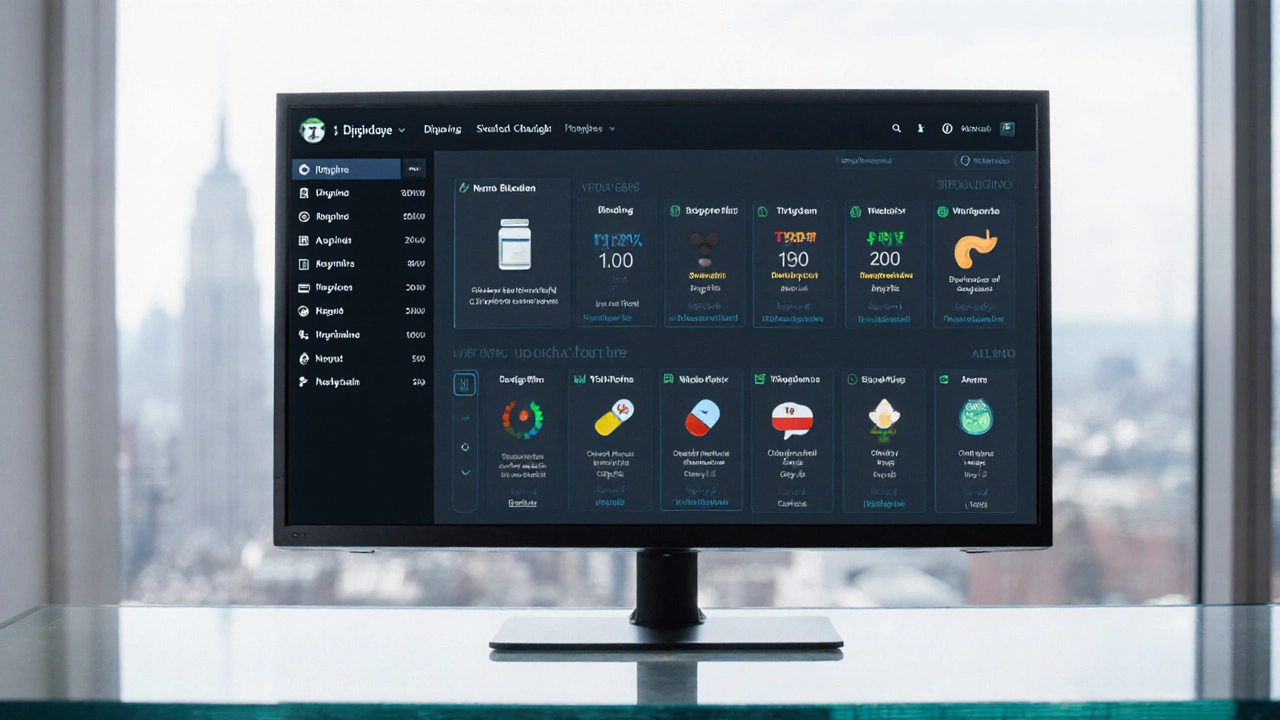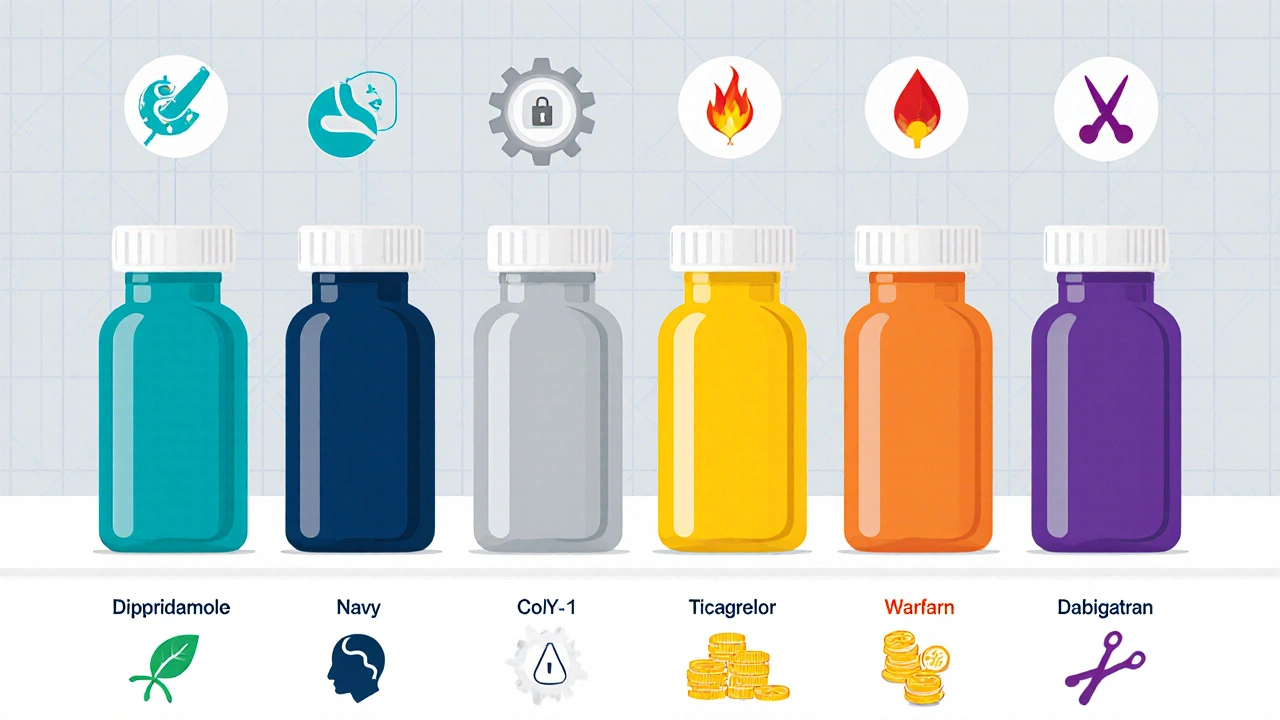Dipyridamole vs Alternatives: Complete Comparison of Benefits, Risks, and Uses

Dipyridamole vs Alternatives: Interactive Comparison Tool
Dipyridamole is effective for secondary stroke prevention when combined with aspirin, but has higher rates of headache and GI upset compared to alternatives.
DOACs like dabigatran offer strong clot prevention for atrial fibrillation but require renal monitoring and are more expensive.
The best choice depends on clinical indication, bleeding risk, renal function, and cost considerations.
Quick Takeaways
- Dipyridamole is a platelet‑aggregation inhibitor often paired with aspirin for stroke prevention.
- Clopidogrel, ticagrelor, aspirin, warfarin, and dabigatran are the most common alternatives.
- Dipyridamole shows modest efficacy in preventing secondary ischemic events but carries a higher risk of headache and GI upset.
- Direct oral anticoagulants (DOACs) like dabigatran provide stronger clot‑prevention for atrial fibrillation but require renal monitoring.
- Choosing the right agent depends on the patient’s indication, bleeding risk, comorbidities, and cost considerations.
What Is Dipyridamole?
Dipyridamole is an oral phosphodiesterase inhibitor that blocks platelet activation by increasing intracellular cAMP levels. It was first approved in the 1970s for use after coronary artery bypass graft (CABG) surgery and later gained a niche role in secondary stroke prevention when combined with low‑dose aspirin.
dipyridamole remains a niche option because newer antiplatelet agents and direct oral anticoagulants often outperform it in large‑scale trials. Still, some guidelines keep it on the list for patients who cannot tolerate clopidogrel or who need an alternative to dual‑antiplatelet therapy (DAPT) after certain procedures.
Common Alternatives
When doctors look for a drug to stop clots, they usually consider one of the following:
- Clopidogrel - a thienopyridine that irreversibly blocks the P2Y12 receptor on platelets.
- Aspirin - an irreversible cyclooxygenase‑1 (COX‑1) inhibitor that reduces thromboxane A2 production.
- Warfarin - a vitamin K antagonist that interferes with synthesis of clotting factors II, VII, IX, and X.
- Ticagrelor - a reversible P2Y12 inhibitor with faster onset and offset than clopidogrel.
- Dabigatran - a direct thrombin inhibitor classified as a DOAC.
Each of these agents has a distinct mechanism, efficacy profile, and safety considerations.

Head‑to‑Head Comparison
| Drug | Mechanism | Typical Indication | Bleeding Risk | Common Side Effects | Cost (US, 2025) |
|---|---|---|---|---|---|
| Dipyridamole | Phosphodiesterase inhibitor → ↑ cAMP | Secondary ischemic stroke (with aspirin) | Low‑moderate | Headache, nausea, flushing | $0.30‑$0.50 per tablet |
| Clopidogrel | Irreversible P2Y12 blocker | Post‑PCI, stroke/TIA secondary prevention | Moderate | Bruising, GI upset | $0.20‑$0.40 per tablet |
| Aspirin | COX‑1 irreversible inhibitor | Primary/secondary CV prevention | Low‑moderate | GI bleeding, dyspepsia | $0.02‑$0.05 per tablet |
| Warfarin | Vitamin K antagonist | AFib, mechanical heart valve | High (INR‑dependent) | Bleeding, skin necrosis | $0.10‑$0.20 per tablet |
| Ticagrelor | Reversible P2Y12 blocker | ACS, PCI | Moderate‑high | Dyspnea, bleeding | $1.50‑$2.00 per tablet |
| Dabigatran | Direct thrombin inhibitor (DOAC) | Non‑valvular AFib, VTE prophylaxis | Moderate | GI upset, dyspepsia | $3.00‑$4.00 per capsule |
How to Choose the Right Agent
The decision tree starts with the clinical indication:
- Is the patient post‑stroke or TIA? Combine low‑dose aspirin with dipyridamole if they can tolerate the headache and have no contraindication to aspirin.
- Is the patient undergoing PCI or has acute coronary syndrome? Clopidogrel or ticagrelor are preferred; ticagrelor gives faster platelet inhibition but may cause dyspnea.
- Is the patient in atrial fibrillation? DOACs like dabigatran usually beat warfarin on safety and convenience, unless severe renal impairment exists.
- Do they have a high bleeding risk? Aspirin alone may be safest; dipyridamole adds modest bleeding without a dramatic increase.
Cost and insurance coverage also sway the choice. Dipyridamole and aspirin are generics and cheap, while ticagrelor and dabigatran are brand‑only and pricey.
Dosage, Administration, and Monitoring
Standard regimens (adult):
- Dipyridamole: 200mg three times daily (extended‑release 400mg twice daily) taken with food to reduce GI irritation.
- Clopidogrel: 75mg once daily; a 300mg loading dose may be used before PCI.
- Aspirin: 81mg-325mg daily, depending on tolerance and indication.
- Warfarin: Dose adjusted to maintain INR 2.0-3.0 for most indications.
- Ticagrelor: 90mg twice daily after a 180mg loading dose.
- Dabigatran: 150mg twice daily (110mg twice daily for patients >80y or high bleed risk).
Monitoring varies. Dipyridamole needs no routine labs, but clinicians watch for persistent headache or hypotension. For warfarin, INR checks are mandatory. DOACs require periodic renal function tests.
Potential Interactions and Contra‑Indications
Key red flags:
- Dipyridamole + other vasodilators (e.g., nitroglycerin) can cause profound hypotension.
- Clopidogrel + CYP2C19 inhibitors (e.g., omeprazole) reduce its activation.
- Aspirin + NSAIDs raise GI bleed risk.
- Warfarin + antibiotics (e.g., trimethoprim‑sulfamethoxazole) can boost INR dramatically.
- Ticagrelor + CYP3A4 inhibitors (e.g., ketoconazole) increase plasma levels and bleeding.
- Dabigatran + P‑gp inhibitors (e.g., amiodarone) elevate exposure; dose adjustment needed.
Absolute contraindications include active major bleeding for all agents, known hypersensitivity, and severe hepatic impairment for most antiplatelets.

Frequently Asked Questions
Can dipyridamole be used alone for stroke prevention?
Guidelines recommend dipyridamole only in combination with low‑dose aspirin. The synergy reduces recurrent ischemic events more than aspirin alone, but dipyridamole by itself hasn’t shown sufficient benefit.
How does dipyridamole’s efficacy compare to clopidogrel?
Large meta‑analyses (e.g., CAPRIE 2022 update) show clopidogrel reduces composite vascular events by about 8% versus aspirin, while dipyridamole‑aspirin combos achieve roughly a 10% reduction versus aspirin alone. Direct head‑to‑head trials are limited, but clopidogrel generally offers more consistent platelet inhibition and fewer headaches.
Is the headache from dipyridamole treatable?
Yes. Taking the extended‑release formulation, splitting the dose with meals, or adding a mild analgesic (acetaminophen) can lessen the discomfort. If headaches persist beyond two weeks, clinicians often switch to an alternative antiplatelet.
Do I need blood tests while on dipyridamole?
Routine labs aren’t required. However, liver function tests are prudent in patients with existing hepatic disease, as dipyridamole is metabolized hepatically.
Which drug is safest for elderly patients with chronic kidney disease?
Low‑dose aspirin or dipyridamole‑aspirin are often preferred because they don’t require dose adjustment for renal function. DOACs need careful dosing (e.g., dabigatran 110mg BID) and warfarin needs close INR monitoring, which can be cumbersome.
Nicole Chabot
October 1, 2025 AT 15:40I've been digging into how dipyridamole stacks up against the newer agents, and it's clear that its niche really hinges on the stroke‑prevention combo with aspirin. The headache side effect is a real turn‑off for many patients, but the cost advantage can't be ignored. For folks with low bleeding risk, it's a decent fallback when clopidogrel isn't tolerated. Also, keep an eye on drug‑drug interactions, especially with other vasodilators. Overall, it still has a place, just not the first‑line for most.
Sandra Maurais
October 2, 2025 AT 02:46In my view, the continued use of dipyridamole is a relic of outdated guidelines – it offers marginal benefit at the expense of patient comfort. 🤨 The headache incidence alone undermines adherence, rendering it inferior to clopidogrel or ticagrelor which have more robust data. Moreover, the cost savings are negligible when compared to the broader insurance coverage of newer agents. It would be prudent for clinicians to retire this antiquated therapy in favor of evidence‑based alternatives. 📉
Michelle Adamick
October 2, 2025 AT 13:53From a pharmacodynamic perspective, dipyridamole's PDE inhibition ↑ cAMP, yielding platelet inhibition that’s synergistic with aspirin’s COX‑1 blockade – essentially a double‑hit on thromboxane pathways 🚀. However, the adverse event profile, especially the vasodilatory headache, translates to higher discontinuation rates versus P2Y12 inhibitors. In real‑world practice, clinicians gravitate toward agents with rapid on‑set and predictable PK/PD, like ticagrelor, for acute coronary syndromes. Cost‑effectiveness analyses still favor generic antiplatelets, but the therapeutic index of dipyridamole is narrower. 🤓
Edward Glasscote
October 2, 2025 AT 22:13Dipyridamole works okay but the headaches are annoying.
Gaurav Joshi
October 3, 2025 AT 07:56Honestly, the hype around dipyridamole is overblown; most patients could just stay on aspirin and avoid the extra pill. The modest efficacy gain doesn't justify adding another drug with its own side‑effects. In settings where bleeding risk is already low, the incremental benefit is virtually invisible. So, unless there's a specific contraindication to clopidogrel, I'd skip the dipyridamole combo.
Jennifer Castaneda
October 3, 2025 AT 19:03The pharmaceutical narrative surrounding dipyridamole seems manufactured to keep older drugs circulating while newer, more profitable formulations dominate the market. Evidence suggests that the combination with aspirin offers only a marginal reduction in recurrent strokes, yet the literature inflates its significance. Moreover, the side‑effect profile-particularly the pervasive headaches-appears deliberately downplayed in promotional material. Patients deserve transparency that the cost‑benefit balance may not be as favorable as claimed. It's essential to scrutinize who benefits from maintaining this regimen in clinical guidelines.
Rajan Desai
October 4, 2025 AT 03:23When evaluating dipyridamole, it's helpful to consider renal function since the drug is hepatically metabolized but can accumulate in certain populations. Have clinicians observed any differences in efficacy between the extended‑release and immediate‑release formulations in stroke patients? Also, is there any emerging data on combining dipyridamole with newer anticoagulants for synergistic effect, or would that raise bleeding concerns? Understanding these nuances can guide personalized therapy choices. Lastly, cost considerations remain pivotal for many patients.
Sangeeta Birdi
October 4, 2025 AT 10:20Thanks for breaking down the mechanisms, Michelle! 😊 It’s true that the double‑hit approach can be appealing, but the patient experience really matters – those headaches can be debilitating. I’ve seen some folks manage them with dose timing adjustments and gentle NSAIDs, which helps. Still, tailoring therapy to individual tolerance is key.
Chelsea Caterer
October 4, 2025 AT 21:26Dipyridamole is cheap but the headache is a pain its not worth it for many patients
Lauren Carlton
October 5, 2025 AT 07:10While the article attempts to be balanced, it contains several inaccuracies. For instance, the claim that dipyridamole has a “low‑moderate” bleeding risk is misleading; the combination with aspirin actually elevates gastrointestinal bleeding incidence. Additionally, the cost comparison neglects insurance copays that often render generic aspirin effectively free. These omissions compromise the utility of the piece for clinicians seeking reliable data.
Katelyn Johnson
October 5, 2025 AT 15:30Everyone has different needs when choosing a blood thinner we should respect those choices and look at each person's medical history and budget together
Anthony Aspeitia-Orozco
October 6, 2025 AT 05:23Dipyridamole occupies a curious niche in the modern antithrombotic armamentarium, offering a mechanistic profile that differs from both traditional aspirin and the newer direct oral anticoagulants.
Its primary action as a phosphodiesterase inhibitor raises intracellular cAMP, which in turn dampens platelet activation pathways.
When paired with low‑dose aspirin, this dual approach can modestly reduce the risk of recurrent ischemic stroke compared with aspirin alone, as demonstrated in several meta‑analyses.
However, the magnitude of benefit is often eclipsed by the frequency of adverse events, particularly the notorious headache that can limit adherence.
Patients who experience intolerable headaches may discontinue therapy prematurely, negating any theoretical advantage.
Moreover, the pharmacokinetic profile of dipyridamole requires dosing three times daily in its immediate‑release form, which can be burdensome for elderly patients with polypharmacy.
The extended‑release formulation offers a more convenient twice‑daily regimen but does not fully eliminate the side‑effect burden.
From a cost perspective, dipyridamole remains inexpensive, making it attractive in resource‑limited settings where brand‑name DOACs are prohibitive.
Yet, the overall cost‑effectiveness must factor in potential downstream costs associated with poor adherence, such as repeat hospitalizations for stroke.
Clinicians must also consider drug‑drug interactions; dipyridamole potentiates the vasodilatory effects of nitrates, sometimes leading to symptomatic hypotension.
In patients with concurrent use of other antiplatelets, the incremental bleeding risk can shift from low‑moderate to moderate, demanding careful monitoring.
For individuals with renal impairment, dipyridamole is generally safe because it is metabolized hepatically, unlike many DOACs that require dose adjustments.
Nevertheless, the lack of robust evidence in patients with severe hepatic disease limits its applicability in that subgroup.
When contrasted with clopidogrel, dipyridamole’s efficacy appears comparable in secondary stroke prevention, but the side‑effect profile is less favorable.
In acute coronary syndrome settings, guidelines favor P2Y12 inhibitors and anticoagulants, relegating dipyridamole to a peripheral role.
Ultimately, the decision to employ dipyridamole should be individualized, weighing the modest efficacy gain against the inconvenience of dosing and the propensity for headaches, while also accounting for patient preferences and economic constraints.
Adam Dicker
October 6, 2025 AT 16:30Listen up, team – if you’re still prescribing dipyridamole without weighing the alternatives, you’re basically betting on a relic while the rest of us are leveraging the power of modern antiplatelets and DOACs. The headache nightmare alone is enough to send patients running for the exit. Combine that with the three‑times‑daily dosing, and you’ve got a compliance disaster. It’s time to retire dipyridamole from the frontline and reserve it for truly niche scenarios where other agents are contraindicated. Let’s move forward with the evidence‑based choices.
Molly Beardall
October 7, 2025 AT 02:13Oh, the tragedy of dipyridamole – a drug that promised so much yet delivers endless migraines and endless frustration! 😱 It’s like the soap opera of stroke prevention, full of dramatic twists but no happy ending. The cheap price tag feels like a cruel joke when patients are forced to endure constant head pounding. Honestly, it’s a villain in the pharmacology saga, and we’d be better off casting it out of the script. The curtain should fall on dipyridamole now.
Brian Pellot
October 7, 2025 AT 09:10Hey Molly, I hear you – the headaches are definitely a drama of their own. 😊 Some patients do manage them with timing adjustments and mild analgesics, which can soften the plot a bit. Still, you’re right that if a better‑tolerated option exists, it should take the lead role. Thanks for sharing your passionate take!